Huawei Technologies U8800 HSPA+/UMTS/GPRS/GSM/EDGE Mobile Phone with BT; HSPA/UMTS/GPRS/GSM/EDGE Mobile Phone with BT User Manual normal qsg u8800
Huawei Technologies Co.,Ltd HSPA+/UMTS/GPRS/GSM/EDGE Mobile Phone with BT; HSPA/UMTS/GPRS/GSM/EDGE Mobile Phone with BT normal qsg u8800
Contents
- 1. User Manual U8800
- 2. User Manual U8800H
User Manual U8800
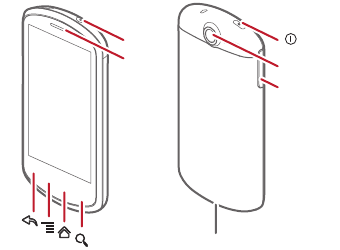
1
What is in Your Box
Phone at a Glance
■ Note:
If you apply protective film on the phone, please use the protective
film with good transmittance.
• Mobile phone
• Charger
• USB cable
• Battery
• Headset
• Quick Start Guide
• Safety Information
Charge/Data port
Camera
Volume
key
Headset
jack
Earpiece
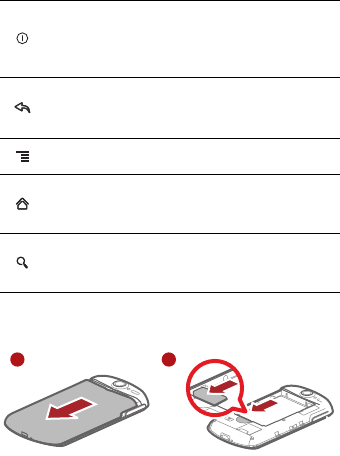
2
Key Functions at Your Fingertips
Installing the SIM Card
• Press to power on your mobile phone.
• Press and hold to open the
Phone options
menu.
• Press to lock the screen when your mobile phone is
active.
• Touch to return to the previous screen.
• Touch to exit any application you are running.
• Touch to hide the keyboard.
Touch to open the menu on an active screen.
• Touch to return to the Home screen.
• Touch and hold to show the most recently used
applications.
• Touch to open Google search for searching your mobile
phone and the web.
• Touch and hold to open Google search by voice.
1 2
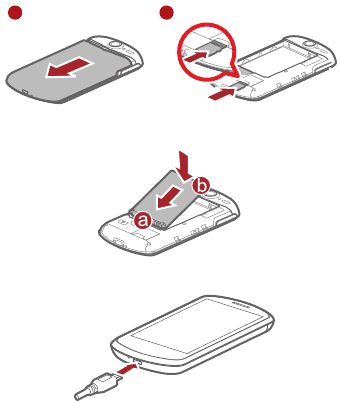
3
Installing the microSD Card (Optional)
Your mobile phone is already equipped with a large-volume built-in
eMMC card. If you want to expand your phone memory, you can also
insert a microSD card.
Installing the Battery
Charging the Battery
If your mobile phone is charged when it is powered on, the battery
icon on the Notification bar shows the charging status. When the
1 2
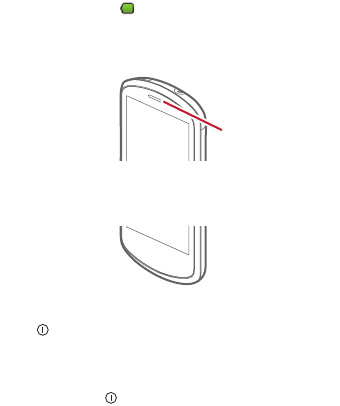
4
battery icon changes to , it indicates that your mobile phone is
fully charged.
Status Indicator
Powering On Your Mobile Phone
Press . The first time you power on your phone, you will be
asked to sign in to your account and set up your mobile phone.
Powering Off Your Mobile Phone
1. Press and hold to open the
Phone options
menu.
2. Touch
Power off
.
3. Touch
OK
.
Status Indicator
Green: Fully charged (when connected to charger).
Orange: Charging in progress (when connected to charger).
Red: Battery low.

5
Home Screen
Viewing Other Parts of the Home Screen
10:23
Touch to open the Phone application.
Touch to view all your applications.
Touch to open the Browser.
Notifications bar:
Displays the reminders and status icons of
your phone. Flick down to open the
notifications panel.
Display area:
Shows the operation and display areas of
your phone.
Screen switching dots:
Indicate the number of the screens on the
left or right. Touch the left or right dots to
switch between the screen.
10:23
Touch and hold the small dots to view thumbnails
of the Home screen and its extensions.
Touch a thumbnail to
open the Home screen
or its extensions.
Flick your finger left or
right across the Home
screen.

6
Adding a New Screen Item
1. Touch and hold a blank area on the Home screen until the
Add
to Home screen
menu is displayed.
2. Select an item to add it to the Home screen.
Changing the Wallpaper
1. On the Home screen, touch >
Wallpaper
.
2. Do any of the following:
• Touch
Live wallpapers
to select a picture and set it as the
wallpaper.
• Touch
Gallery
to select a picture and set it as the wallpaper.
• Touch
Wallpapers
to select a picture and set it as the
wallpaper.
Locking the Screen
• When your mobile phone is on, press to lock the screen.
When the screen is locked, you can still receive messages and
calls.
• If your mobile is idle for a while, the screen will lock
automatically.
Unlocking the Screen
1. Press to wake up the screen.
2. Drag the lock icon from left to right to unlock the screen.
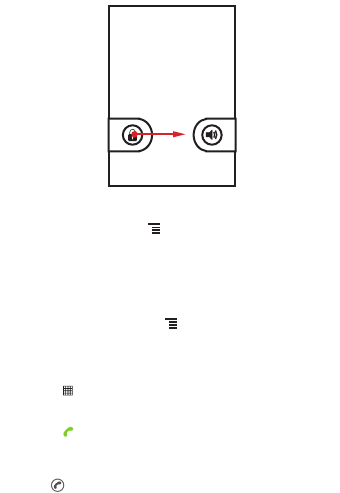
7
Importing Contacts from a SIM Card
1. In the contact list, touch >
Import/Export
.
2. Touch
Import from SIM card
.
3. If you have more than one account on your phone, touch the
account into which you want to import the contacts.
4. Wait for the SIM card contents to be loaded. Select the contacts
you want to import or touch >
Import all
to import all
contacts.
Making a Call with the Phone Application
1. Touch >
Phone
to display the dialer.
2. Touch the appropriate numeric keys to enter the phone number.
3. Touch to initiate the call.
Answering an Incoming Call
Drag the to the right to answer the call.
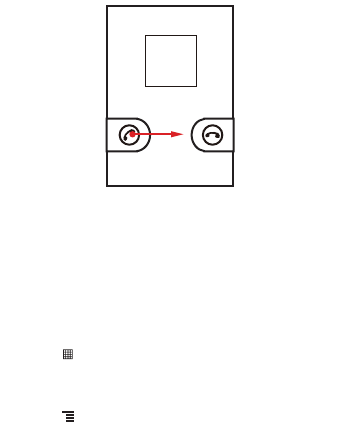
8
Choosing an Input Method
1. Touch and hold the space where you enter your text until the
Edit text
menu is displayed.
2. Touch
Input method
.
3. Select the input method.
The keyboard panel will be displayed automatically.
Creating and Sending a Multimedia Message
1. Touch >
Messaging
>
New message
.
2. Enter a phone number in the
To
field.
3. Touch the composition text box to start entering your message.
4. Touch to display the options panel.
• Touch
Add subject
to add the message subject. Your mobile
phone is now in multimedia message mode.
• Touch
Attach
to add a picture, music, or video file.
5. When the message is ready to be sent, touch
Send
.

9
Turning on the Data Service
1. Touch >
Settings
.
2. Touch
Wireless & networks
>
Mobile networks
.
3. Select the
Data enabled
check box to turn on the data
connection.
Turning On Wi-Fi
1. Touch >
Settings
.
2. Touch
Wireless & networks
, and then select the
Wi-Fi
check
box to turn on Wi-Fi.
Sharing Your Phone’s Data Connection via
USB
To use USB tethering in different operating systems, you may need
to prepare your computer to establish a network connection via USB.
■ Note:
You can not share your mobile phone’s data connection and SD card
via USB at the same time.
1. Touch >
Settings
.
2. Touch
Wireless & networks
>
Tethering
.
3. Select the
USB tethering
check box to share your data
connection.
Opening Your Camera
• Touch >
Camera
to open the camera. The camera opens
in landscape mode, ready to take a picture or record a video.
• Touch to close the camera.
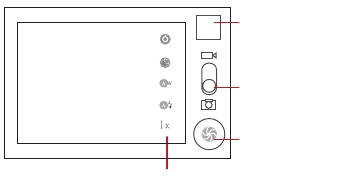
10
Capture Screen
Using the microSD Card as USB Mass
Storage
1. Connect your mobile phone to your PC with the USB cable. Your
PC will detect the microSD card as a removable disk.
2. Open the notification bar, and then touch
USB connected
.
3. Touch
Turn on USB storage
in the dialog box that opens to
confirm that you want to transfer files.
You can now transfer files from your PC to your mobile phone’s
microSD card.
Warnings and Precautions
Operating Environment
• The device complies with the RF specifications when the device
is used near your ear or at a distance of 1.5 cm from your body.
Ensure that the device accessories such as a device case and a
device holster are not composed of metal components. Keep
3
5
Touch to customize the camera settings.
Thumbnail of last
photo. Touch to
preview the photos
or videos.
Drag up to record
videos, drag down
to take photos.
Touch to take a
photo.
11
your device 1.5 cm away from your body to meet the requirement
earlier mentioned.
• While using the device, observe the local laws and regulations,
and respect others' privacy and legal rights.
• Keep the ambient temperature between -10°C and 45°C while
the device is being charged. Keep the ambient temperature
between -10°C to 55°C for using the device powered by a battery.
Certification Information (SAR)
This device meets guidelines for exposure to radio waves.
Your device is a low-power radio transmitter and receiver. As
recommended by international guidelines, the device is designed not
to exceed the limits for exposure to radio waves. These guidelines
were developed by the independent scientific organization
International Commission on Non-Ionizing Radiation Protection
(ICNIRP) and include safety measures designed to ensure safety for
all users, regardless of age and health.
The Specific Absorption Rate (SAR) is the unit of measurement for
the amount of radio frequency energy absorbed by the body when
using a device. The SAR value is determined at the highest certified
power level in laboratory conditions, but the actual SAR level of the
device when being operated can be well below the value. This is
because the device is designed to use the minimum power required
to reach the network.
The SAR limit adopted by USA and Canada is 1.6 watts/kilogram (W/
kg) averaged over one gram of tissue. The highest SAR value
reported to the FCC and IC for this device type when tested for use
at the ear is 0.329 W/kg, and when properly worn on the body is
0.773 W/kg.
The SAR limit also adopted by Europe is 2.0 W/kg averaged over 10
grams of tissue. The highest SAR value for this device type when

12
tested at the ear is 0.372 W/kg, and when properly worn on the body
is 0.562 W/kg.
FCC Statement
This equipment has been tested and found to comply with the limits
for a Class B digital device, pursuant to Part 15 of the FCC Rules.
These limits are designed to provide reasonable protection against
harmful interference in a residential installation. This equipment
generates, uses and can radiate radio frequency energy and, if not
installed and used in accordance with the instructions, may cause
harmful interference to radio communications. However,there is no
guarantee that interference will not occur in a particular installation.If
this equipment does cause harmful interference to radio or television
reception,which can be determined by turning the equipment off and
on, the user is encouraged to try to correct the interference by one or
more of the following measures:
--Reorient or relocate the receiving antenna.
--Increase the separation between the equipment and receiver.
--Connect the equipment into an outlet on a circuit different from that
to which the receiver is connected.
--Consult the dealer or an experienced radio/TV technician for help.
This device complies with Part 15 of the FCC Rules. Operation is
subject to the following two conditions: (1) this device may not cause
harmful interference, and (2) this device must accept any
interference received, including interference that may cause
undesired operation.
Caution
Changes or modifications made to this device not expressly
approved by Huawei Technologies Co., Ltd. may void the FCC
authorization to operate this device.

13
Disposal and Recycling Information
This symbol on the device (and any included batteries) indicates that
they should not be disposed of as normal household garbage. Do not
dispose of your device or batteries as unsorted municipal waste. The
device (and any batteries) should be handed over to a certified
collection point for recycling or proper disposal at the end of their life.
For more detailed information about the recycling of the device or
batteries, contact your local city office, the household waste disposal
service, or the retail store where you purchased this device.
The disposal of this device is subject to the Waste from Electrical and
Electronic Equipment (WEEE) directive of the European Union. The
reason for separating WEEE and batteries from other waste is to
minimize the potential environmental impacts on human health of
any hazardous substances that may be present.
Reduction of Hazardous Substances
This device is compliant with the EU Registration, Evaluation,
Authorisation and Restriction of Chemicals (REACH) Regulation
(Regulation No 1907/2006/EC of the European Parliament and of
the Council) and the EU Restriction of Hazardous Substances
(RoHS) Directive (Directive 2002/95/EC of the European Parliament
and of the Council). For more information about the REACH
compliance of the device, visit the Web site
www.huaweidevice.com/certification
. You are recommended to
visit the Web site regularly for up-to-date information.

14
EU Regulatory Conformance
Hereby, Huawei Technologies Co., Ltd. declares that this device is in
compliance with the essential requirements and other relevant
provisions of Directive 1999/5/EC.
For the declaration of conformity, visit the Web site
www.huaweidevice.com/certification
.
■ Note:
Observe the national local regulations in the location where the
device is to be used. This device may be restricted for use in some
or all member states of the European Union (EU).
■ Note:
This device may be operated in all member states of the EU.
France
: Outdoor use limited to 10 mW e.i.r.p. within the band 2454-
2483.5 MHz.
Italy
: For private use, a general authorisation is required if WAS/
RLAN’s are used outside own premises. For public use, a general
authorisation is required.
Luxembourg
: General authorisation required for network and
service supply.
Norway
: This subsection does not apply for the geographical area
within a radius of 20 km from the centre of Ny-Ålesund.

15
FAQ
How do I prevent automatic switching of orientation when
rotating phone?
Touch >
Settings
>
Display
>
Auto-rotate screen
to disable
the function.
How do I set the unlock pattern?
Touch >
Settings
>
Location & security
>
Set up screen lock
>
Pattern
.
How can I change the keyboard mode?
Touch and hold the area where you write text and then select the
input method you prefer.
How do I stop the song playing in the background?
Touch the notification bar, flick downwards to open the notifications
panel, and then touch the music playing notification to go to the
music playing screen.
How do I return to the calling screen?
While on a call, if you’re on another screen, you can touch the
notification bar, and drag downwards to open the notifications panel.
Then touch the current call notification to return to the calling screen.
How do I create an application shortcut on the Home
screen?
Touch and hold an application icon on the main menu screen until
the Home screen is displayed. Then drag the icon where you want it
to go and release your finger.

16
How do I hide the keyboard?
Touch to hide the keyboard.